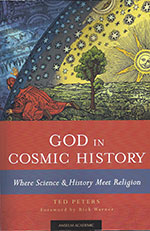
Using the principles of “Big History,” Ted Peters’s God in Cosmic History: Where Science and History Meet Religion broadens the scope and method of traditional history in order to make room for the all-important God question. This expanded history pauses on the “Axial Age” of human history: a moment during the first millennium in which questions of transcendence first simultaneously arose in distinct locations around the world. By exploring this threshold in cosmic history, Peters demonstrates the way the arrival of the God question marked a radical new human consciousness, one that ultimately laid the groundwork for the modern age.
Does a scientific account of human and natural history have room for the question of God?
Perhaps inadvertently, historians have often eliminated the religious chapters―those episodes in history during which human insights into transcendence and divinity have shaped human consciousness―from our planet’s story.
Ted Peters’s God in Cosmic History: Where Science and History Meet Religion tells the story of cosmic history as big historians tell it, beginning with the big bang, and explores the question of God hidden beneath this story. This expanded history begins with the big bang, offering a readable account of nature’s history before our hominid ancestors. God in Cosmic History pauses on the Axial Age of human history: a moment during the first millennium BCE in which questions of transcendence first simultaneously arose in distinct locations around the world. By exploring this threshold in cosmic history, Peters demonstrates the way the arrival of the God question marked a radical new human consciousness, one that ultimately laid the groundwork for the modern age.

